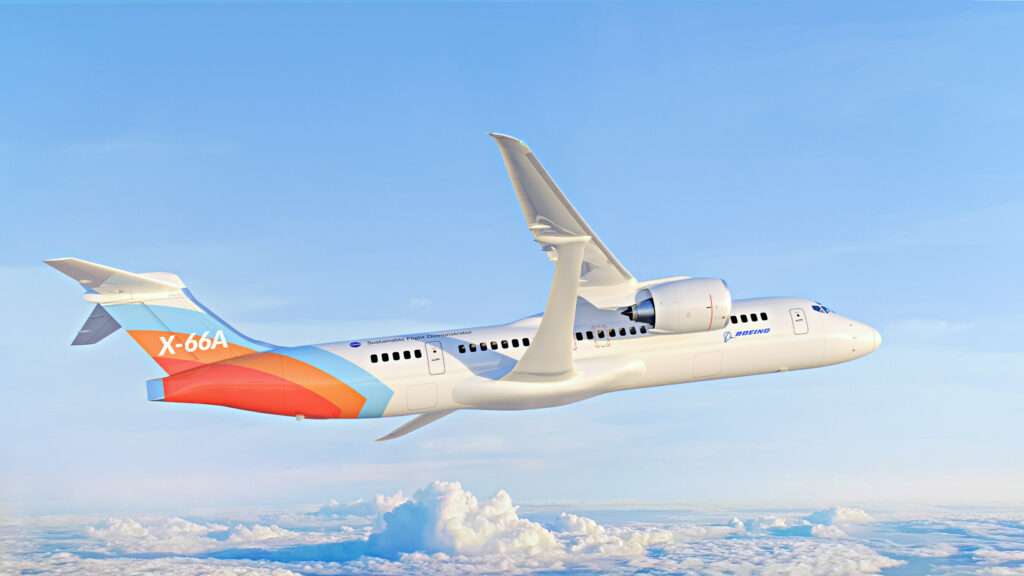RTX has been selected by Boeing as a collaborator on the X-66A flight demonstrator, part of NASA’s Sustainable Flight Demonstrator project.
RTX is the world’s largest aerospace and defense company, operating through its business units Collins Aerospace, Pratt & Whitney and Raytheon.
Pratt & Whitney and Collins Aerospace
RTX will bring its formidable expertise to the table through two of its business units: Pratt & Whitney and Collins Aerospace.
Pratt & Whitney will contribute its groundbreaking GTF™ engines, while Collins Aerospace will provide nacelles and engine accessories.
These components are poised to play a pivotal role in Boeing‘s ambitious X-66A flight demonstrator project, which is slated to kick off in 2028.
Sustainable Flight Demonstrator
The Sustainable Flight Demonstrator is a vital cog in NASA’s broader Sustainable Flight National Partnership, an initiative dedicated to developing technologies that will help the aviation industry achieve net-zero CO2 emissions.
Boeing’s X-66A program, a central part of this endeavor, is laser-focused on advancing the Transonic Truss-Braced Wing (TTBW) concept.
This innovation holds the potential to usher in a new era of fuel efficiency and reduced emissions for the next generation of single-aisle aircraft.
Geoff Hunt, Senior Vice President of Engineering & Technology at Pratt & Whitney, emphasized the significance of NASA’s Sustainable Flight Demonstrator, stating,
“NASA’s Sustainable Flight Demonstrator is a leading example of how public-private partnerships can help foster the technological breakthroughs needed to deliver on the industry-wide goal of a more sustainable, net-zero emissions future.”
This underscores the vital role that collaboration between industry leaders and government agencies plays in propelling aviation toward a cleaner future.
The GTF Engine
Pratt & Whitney’s GTF engine boasts a revolutionary geared fan architecture, setting a new standard for fuel efficiency and sustainability in single-aisle aircraft.
With a remarkable 20% improvement in fuel efficiency, GTF engines have already saved airlines more than 1.4 billion gallons of fuel and over 14 million metric tons of CO2 emissions since their debut in 2016.
Notably, these engines are certified to run on sustainable aviation fuel (SAF) and offer an astonishing 75% reduction in aircraft noise compared to their predecessors.
Collins Aerospace’s Contribution
Collins Aerospace is no stranger to innovation and collaboration within the aerospace industry. Dr. Mauro Atalla, Senior Vice President of Engineering & Technology for Collins, highlighted their extensive experience in pushing the boundaries of aerospace innovation.
He stated, “Now, as part of the Sustainable Flight Demonstrator program, we will work together to demonstrate new technologies and systems to support the next generation of low-emission single-aisle aircraft that will play an integral role in reducing the environmental footprint of the aviation industry.”
Nacelles and Engine Accessories
Collins’ nacelles are a marvel of engineering, crafted from lightweight and durable composite and metallic materials.
These nacelles serve multiple crucial functions, including safeguarding the engine, controlling airflow, reducing noise, and enabling thrust reversal for deceleration during aircraft landings.
Additionally, Collins supplies essential control system components for the GTF engine, including heat exchangers, the integrated fuel pump and control, the air turbine starter, and electronic controls.
Dr. Todd Citron, Boeing’s Chief Technology Officer, highlighted the importance of collaborations like the Sustainable Flight Demonstrator.
He stated, “The learnings from the Sustainable Flight Demonstrator, X-66, and the partnership with NASA are important elements in the industry’s efforts to decarbonize aviation.”
Pioneering Sustainable Aviation
RTX is at the forefront of pioneering technologies for a sustainable aviation future. Their efforts extend to engine readiness for unblended 100% SAF, hybrid-electric propulsion, and hydrogen fuel.
In addition to their collaboration on the Sustainable Flight Demonstrator, Pratt & Whitney and Collins are actively engaged with NASA on other Sustainable Flight National Partnership projects, including Hybrid Thermally Efficient Core (HyTEC) and Hi-Rate Composite Aircraft Manufacturing (HiCAM).









